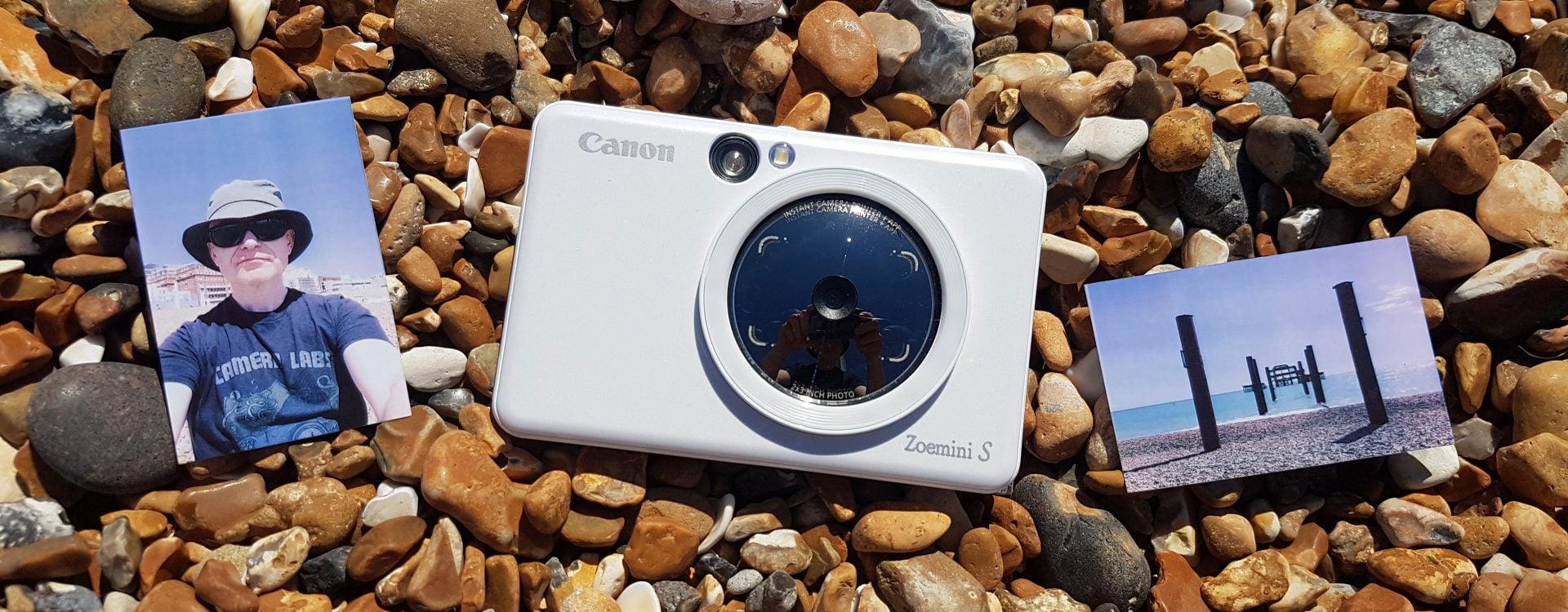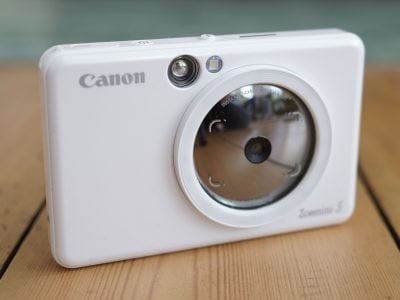Canon Zoemini S IVY Cliq+ review
-
-
Written by Gordon Laing
Canon’s Zoemini S, or IVY Cliq+ as it’s known in North America, is an instant camera with an 8 Megapixel sensor and built-in printer that can output 2x3in colour prints within a minute of taking them; it’ll also let you print photos from your phone using a free app and a Bluetooth connection.
Announced in March 2019 alongside the more basic Zoemini C, or IVY Cliq model, they’re actually Canon’s first instant cameras, with the company hungry for a slice of the lucrative market currently dominated by Fujifilm’s INSTAX products. You’re looking at around 150 GBP for the Zoemini S in the UK or $160 for the IVY Cliq+ in the US – for clarity I’ll refer to it as the Zoemini S for the rest of this review, but both models are identical other than their names. In my video review below I’ll show you everything you need to know about Canon’s first instant camera and how it compares to rival models; if you prefer to read my review, keep scrolling for the highlights! Also see my Fujifilm INSTAX Mini 9 review, Fujifilm INSTAX SQ6 review and Fujifilm INSTAX Share SP3 review.
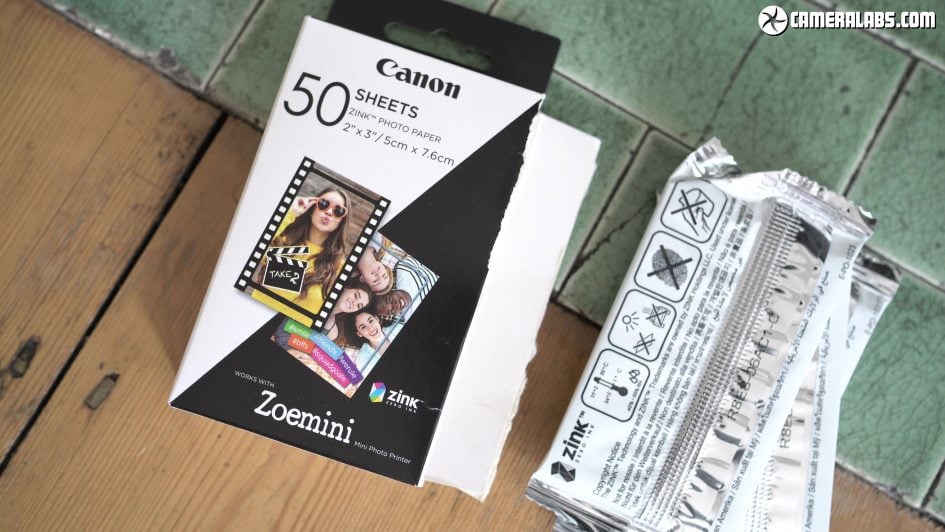
Above: Both the Zoemini S and C employ the same Zero Ink (or Zink) printing technology previously used on Canon’s original Zoemini instant printer from late 2018, so all share the same print quality. The same Zink technology is also employed by some instant cameras and printers by Polaroid and Kodak, and in theory the media should be interchangeable although Canon of course recommends you buy their paper.
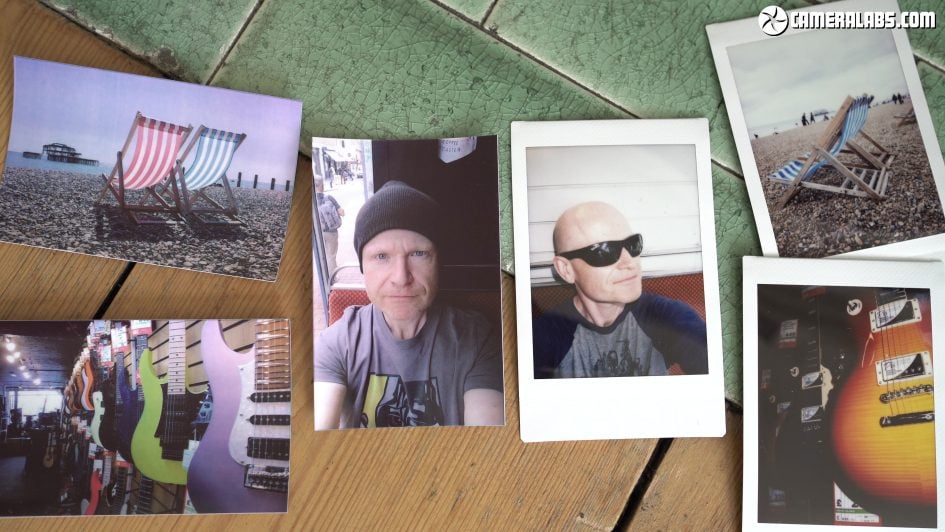
Above: Here’s a selection of Canon Zink prints on the left and Fujifilm INSTAX Mini ones on the right, Zink generates 2x3in borderless prints with sticky backs and are sold in packs of 20 or 50, working out around 50p or 50 cents per print. These work out a bit larger and a little cheaper than Fujifilm’s INSTAX Mini format which has an image area of 1.8×2.4in and cost around 70p or 70 cents each.
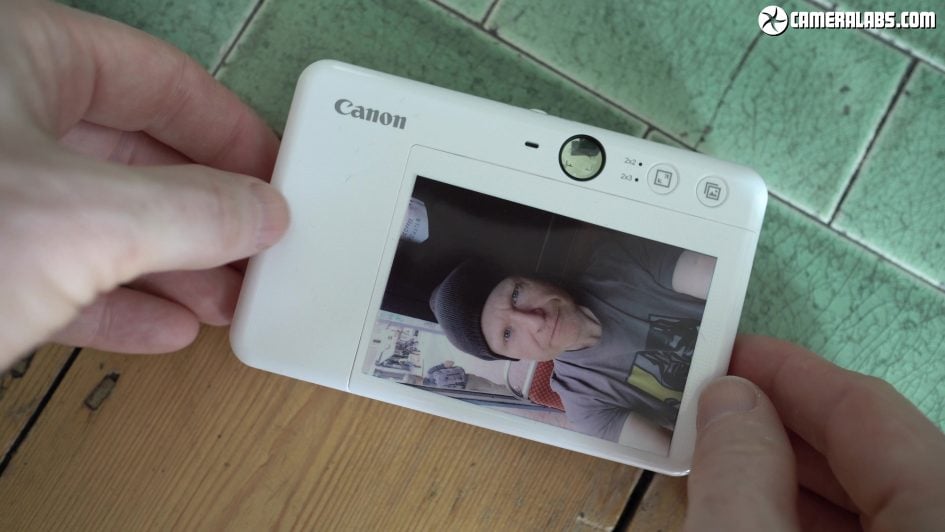
Above: Peeling the back coating to turn Zink prints into stickers is a key benefit it has over INSTAX, allowing you to quickly apply them to items – everyone knows this is my camera now!
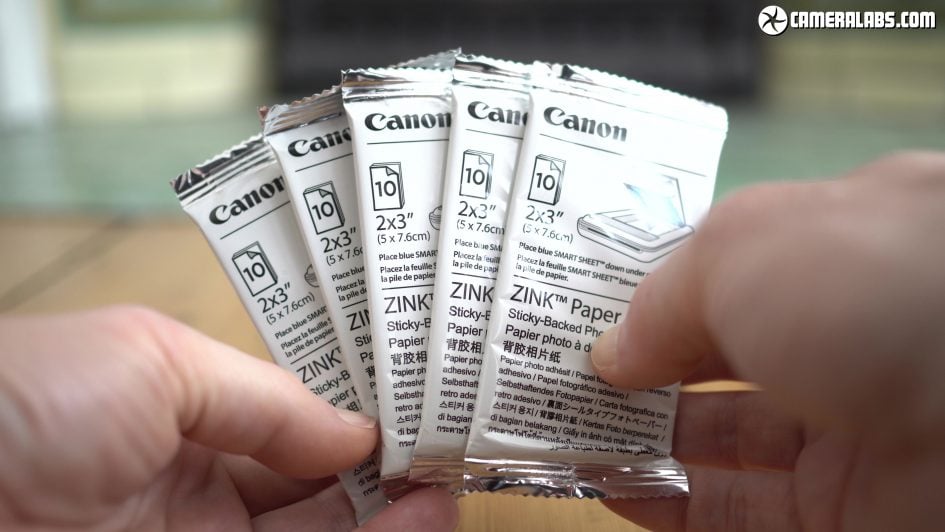
Above: Zink paper is supplied in packs of 10 prints sealed in a foil wrapper. Unlike INSTAX, they’re not light sensitive, nor are they contained in disposable plastic cartridges, but there is a sheet of blue card to indicate which way up they should be inserted into the camera, and this is also used to calibrate the printer for each pack. Once you’ve used all ten prints, the only waste is the blue card and the foil wrapper.
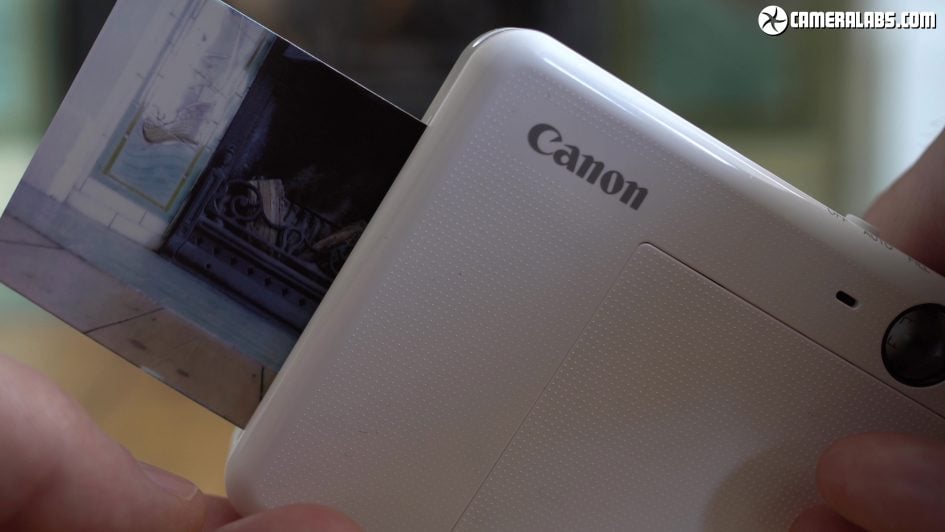
Above: Like INSTAX, there’s no separate ink or ribbon, with everything you need to make a print actually embedded in the paper itself. The actual technology is different though, with Zink embedding three layers of crystals, one each for cyan, magenta and yellow, which are activated at different temperatures generated by the print head as the paper passes by it. Unlike INSTAX prints which emerge almost immediately but take well over a minute for the image to fully appear, Zink keeps the paper inside for a few seconds, before outputting the print in its final state around one minute after taking the photo. I haven’t used it long enough to comment on print longevity yet, but will update my written review at cameralabs.com after a few months.
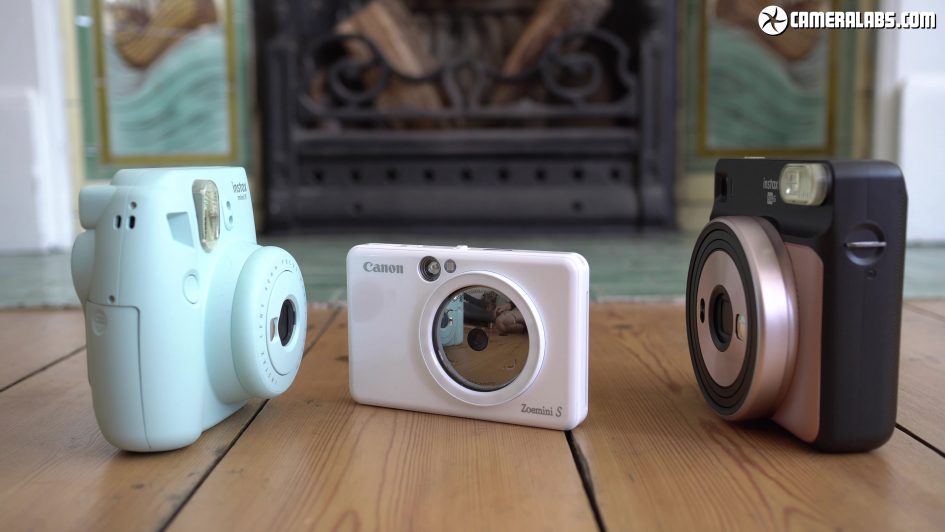
Above: The Zoemini S is a pretty compact camera, roughly similar in size to two packs of playing cards. Measuring 121x80x22mm, weighing 188g and available in matte black, rose gold or pearl white, it’s much more pocketable than the comparatively chunky Fujifilm INSTAX Mini 9 on the left or the SQ6 on the right. Fujifilm does make smaller versions, but they’re still not going to squeeze into your pocket, whereas the Zoemini will, and that of course that means you’re more likely to take it with you.
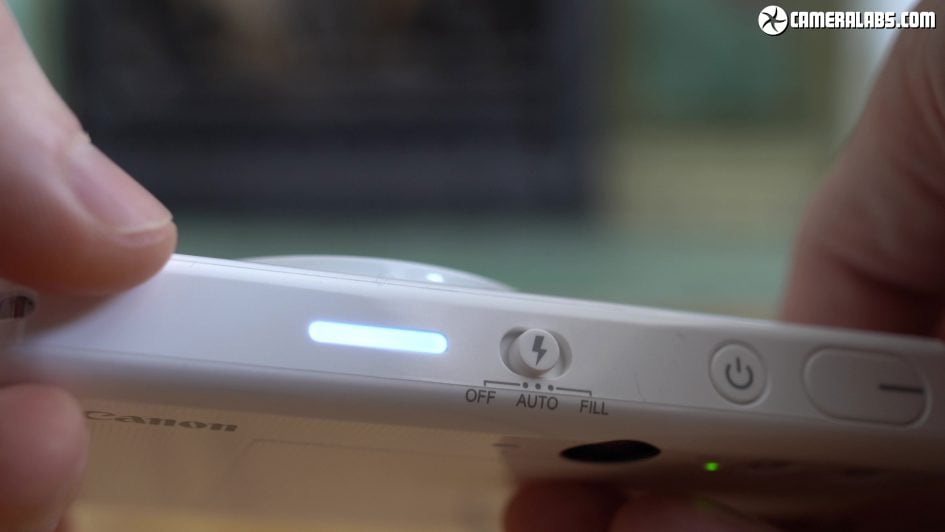
Above: On the top surface is a light which glows different colours to indicate the status or any problems, a switch to set the flash on, off or auto, a power button and a lozenge-shaped shutter release.
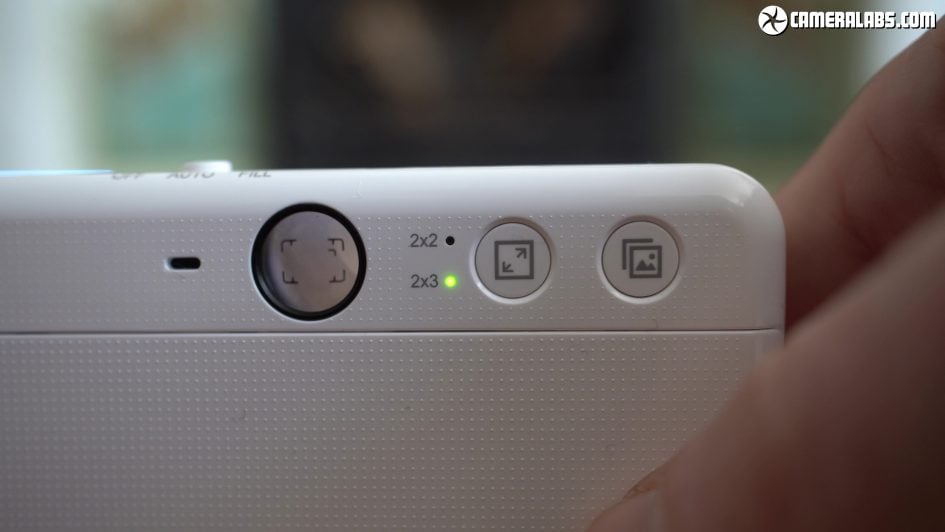
Above: Round the back you’ll find a basic optical viewfinder, a button which lets you choose between the full 2x3in print or a square 2x2in area, and another which prints the last picture again if you need a spare – you can keep doing this if you’re handing them out. Meanwhile you’ll load the paper behind a large removeable panel; you’ll notice unlike INSTAX there’s no indication how many prints are remaining, but there’s nothing stopping you opening the panel and simply counting them.
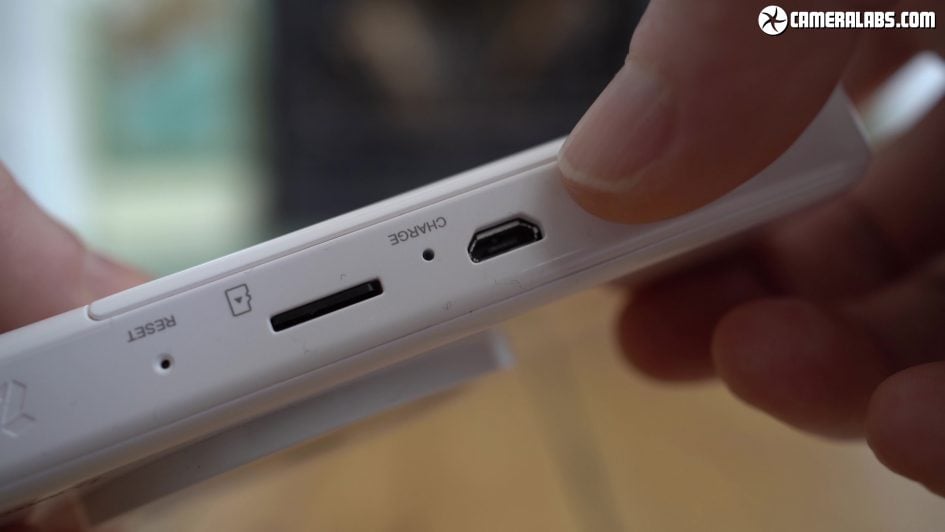
Above: Finally underneath the body is a Micro USB port to charge the built-in battery and a Micro SD card slot. A fully charged battery is good for around 25 prints compared to around 100 on a Mini 9 powered by a pair of AAs. The Micro SD slot confirms the Zoemini’s status as an actual digital camera. Unlike the fully analogue INSTAX Mini 9, the Zoemini S has a small digital sensor and if you insert a memory card, it’ll store the 8 Megapixel JPEG images on there. I’ll show you a bunch of them later, but for now note that while the Zoemini S has a digital sensor, it does not include a screen for reviewing images. Every time you press the shutter button a piece of paper emerges. While this crap-shoot is part of the charm of instant cameras, those who prefer to review first before printing may prefer Kodak’s SMILE camera which also uses Zink and includes a basic screen, or Fujifilm’s INSTAX SQ20 which uses larger square prints but driven by a digital sensor and screen.
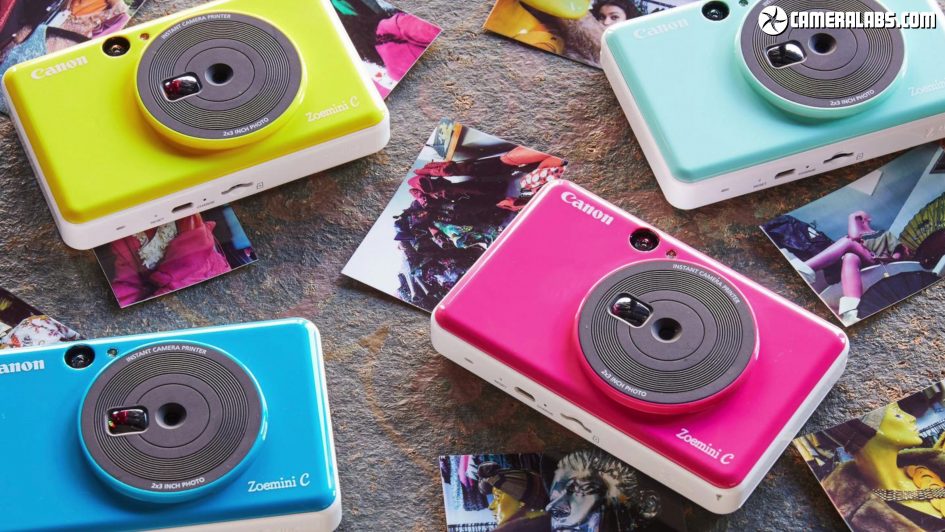
Above: The cheaper Zoemini C employs a slightly lower resolution 5 Megapixel sensor and is available in an arguably cuter selection of colours, but for most people the biggest differences between them can be seen from the front. The Zoemini C has a single LED flash lamp next to the viewfinder window and a small reflective panel for composing selfies like the INSTAX Mini 9.
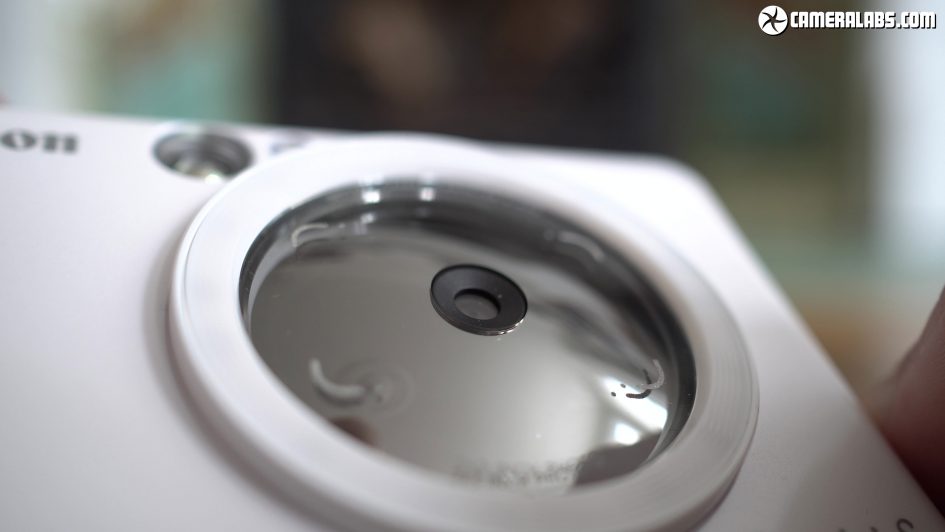
Above: In contrast the Zoemini S offers a much larger circular mirror on the front for selfies with markings to indicate where to position yourself.
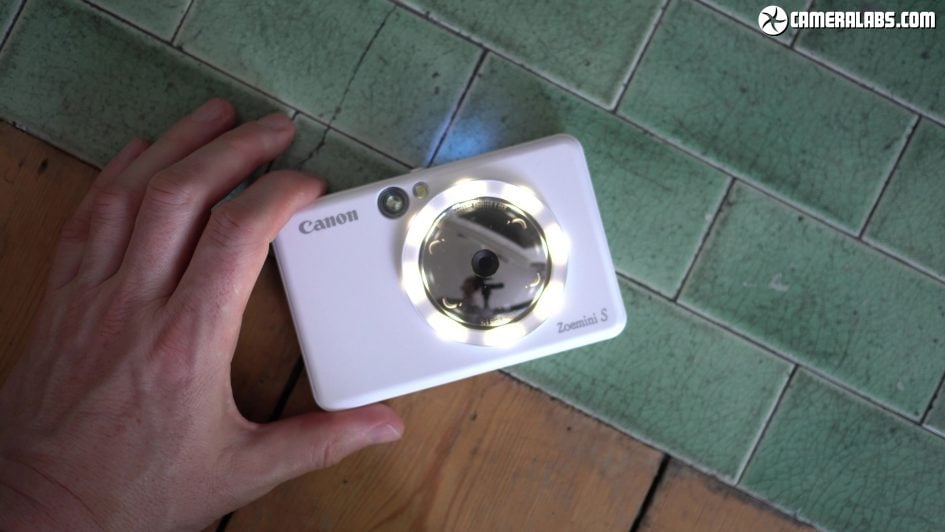
Above: More importantly there’s the addition of eight LEDs around the edge, acting as a basic ring light. This provides not just more illumination than the single flash of the Zoemini C – although that’s also present here – but more flattering lighting and reflections in pupils. Don’t get too excited, it’s not like a high-end ring light, but it remains a classy feature of the Zoemini S.
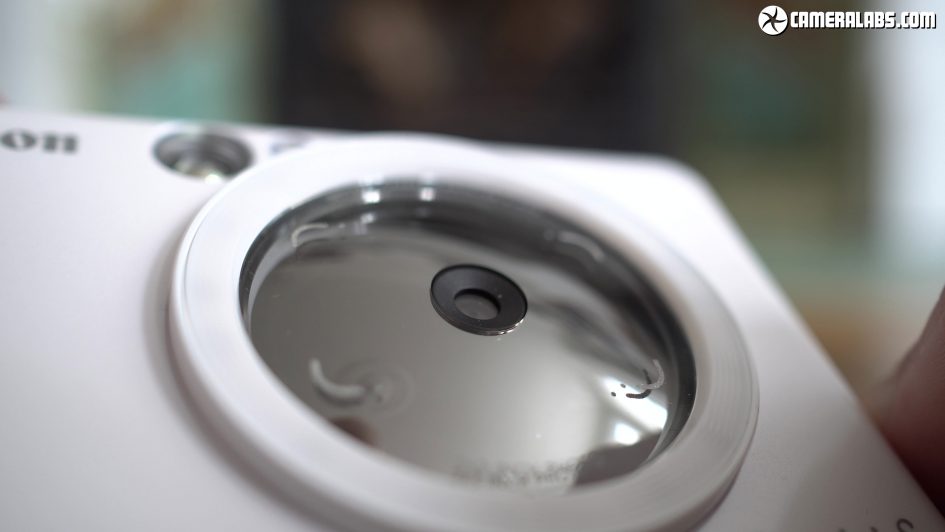
Above: In terms of the lens itself, Canon doesn’t quote the focal length or equivalent coverage, but I found the images roughly matched the coverage of my Samsung Galaxy S7 rear camera which is equivalent to around 26mm. Unlike the fixed focus of the INSTAX Mini 9, the Zoemini S offers basic autofocus from 30cm to infinity, as well as auto exposure, auto sensitivity (from 100-1600 ISO) and auto white balance too. So while there’s no manual control over exposure on the camera itself, the Zoemini S is at least better-equipped than the fully analogue INSTAX cameras to deal with broader lighting. For example at times when a sunny scene was just too bright for the fixed sensitivity, slow shutter and smallest aperture of the Mini 9, the Zoemini S coped just fine.
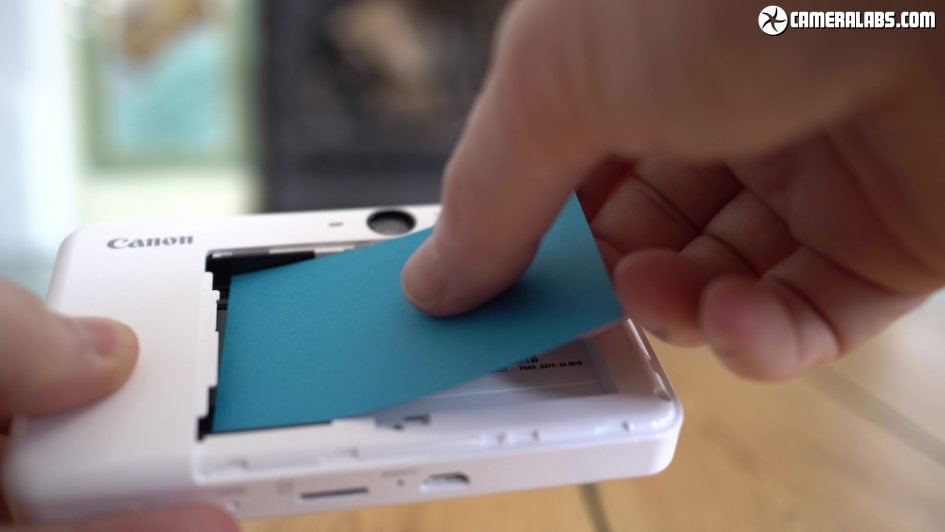
Above: As mentioned earlier, the Zoemini squirts out a print every time you push the shutter, whether you have an SD card inserted or not, and in fact the shutter refuses to fire if there’s no paper loaded. This is frustrating if you run out of paper and just want to snap a shot on the SD card, but I found you could reload the blue calibration card to allow the camera to fire. I’m not sure if doing so repeatedly would damage the camera though, so do so at your own risk.
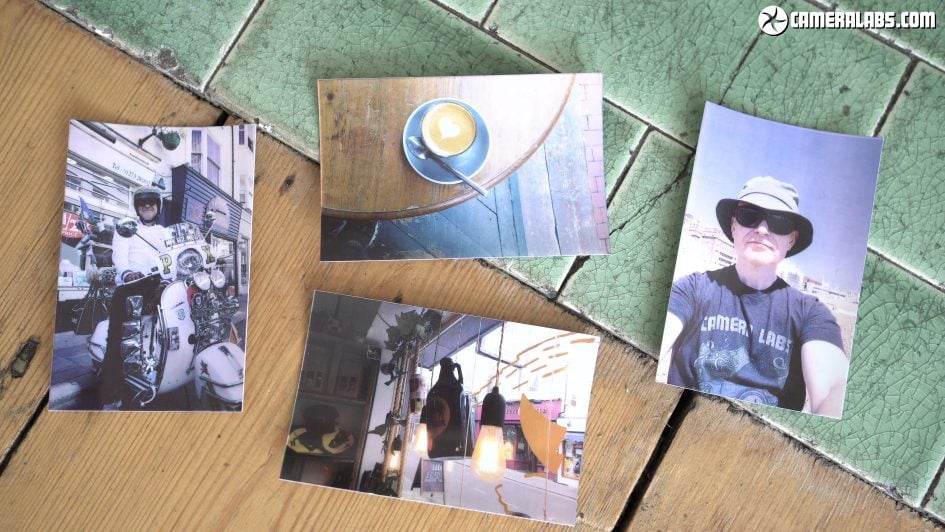
Above: The actual print quality in my tests was basic but ok. The Zink technology isn’t anywhere near as contrasty or vibrant as the INSTAX process and side-by-side the Zoemini prints can’t help but look a bit flat. I also noticed a minor but consistent magenta pink cast to most of my prints which wasn’t visible on the original JPEGs, while flat areas of colour like a solid blue sky were sometimes a little banded. But on the upside the images are a little bigger than INSTAX Mini and fill the paper without borders, I suffered from far fewer failed images with no over-exposures, and you also get to peel-off a backing and use them as stickers. Plus the prints are a little cheaper too – 50p or cents versus 70p or cents. So there’s pros and cons to both formats. I should say though, whenever I show any instant cameras to most people, they’re generally won-over by the instant nature and rarely comment on the actual print quality.

Above: Looking at the digital files from the camera itself, the 8 Megapixel images looked similar to a basic phone – not exactly packed with detail, but pleasingly crisp across the frame. As a small sensor though, do expect noise in low light or shadow areas. You’ll also notice the sensor captures taller 4:3 shaped images which are cropped into a wider 3:2 shape by the printer.
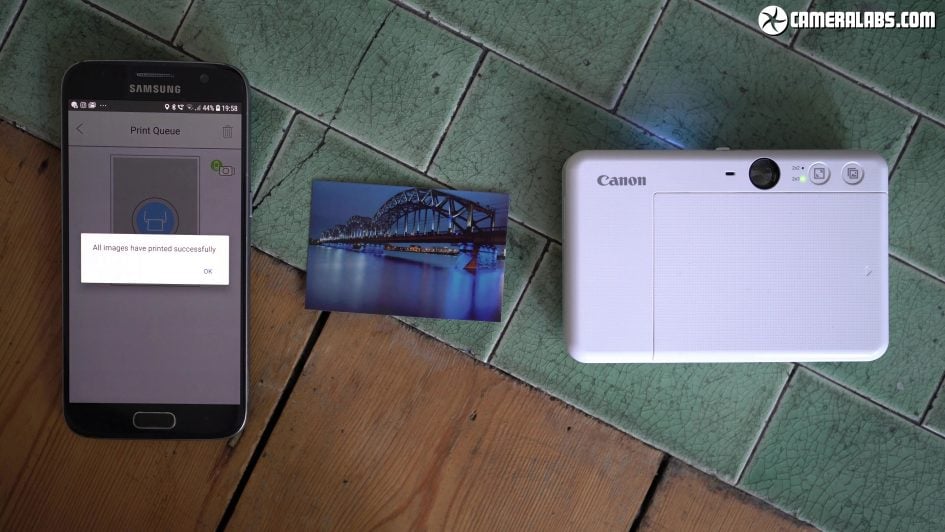
Above: One of the key selling points of the Zoemini cameras are their ability to be used as instant printers for your phone, connected over Bluetooth. Just install Canon’s free app for Android or iOS and you can print any photo that’s on your phone, including those captured by other cameras and copied onto your handset first.
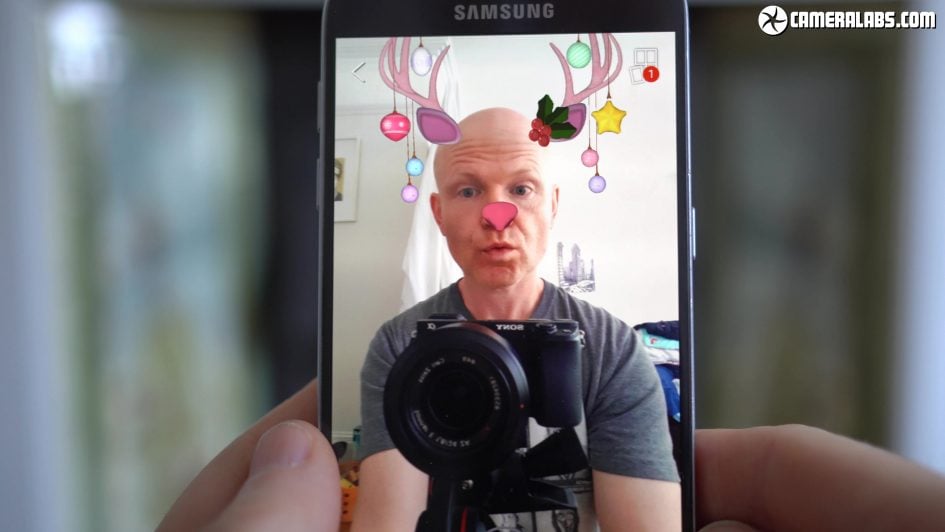
Above: You can also capture new selfies with the app, with various fun effects and augmented graphics.
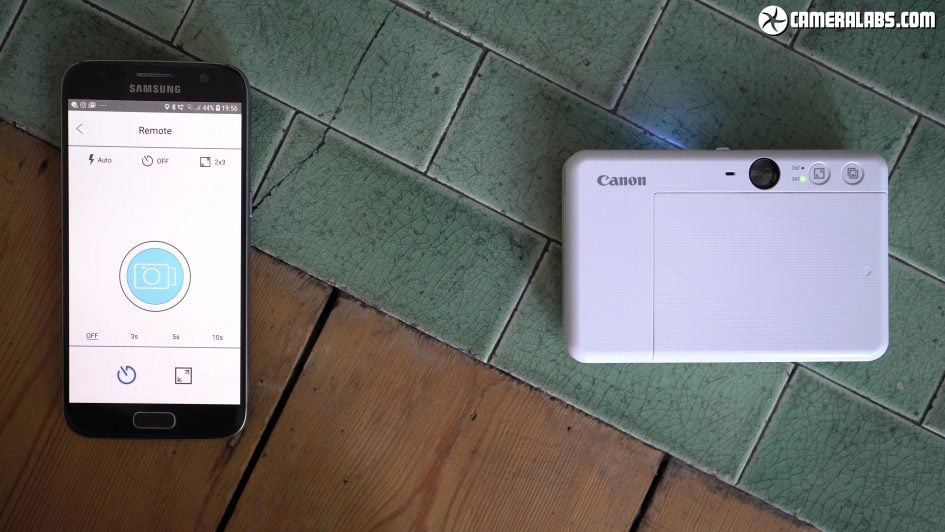
Above: You can even trigger the shutter in the Zoemini itself remotely, although in the absence of a tripod thread or any kind of feedback on the composition, remote group shots may take a few goes. You can’t yet print directly from a Canon camera though, unlike the INSTAX Share printers which not only print from your phone but also direct from Fujifilm cameras.
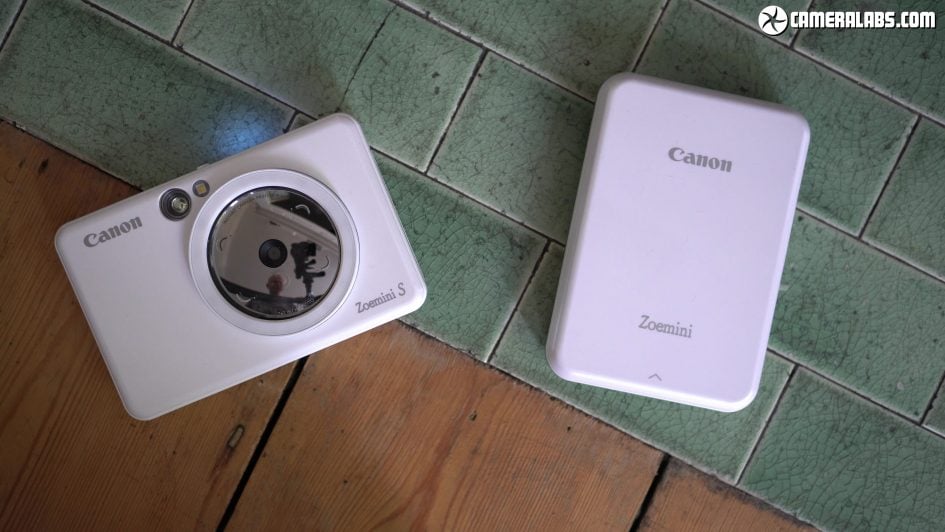
Above: If the idea of printing from your phone or a bigger camera appeals more than using the basic camera in the Zoemini S itself, then you may be better off just buying a portable instant printer instead. Canon has its own Zoemini printer (above) which is like the Zoemini S without a built-in camera, while Kodak has its similar SMILE printer.
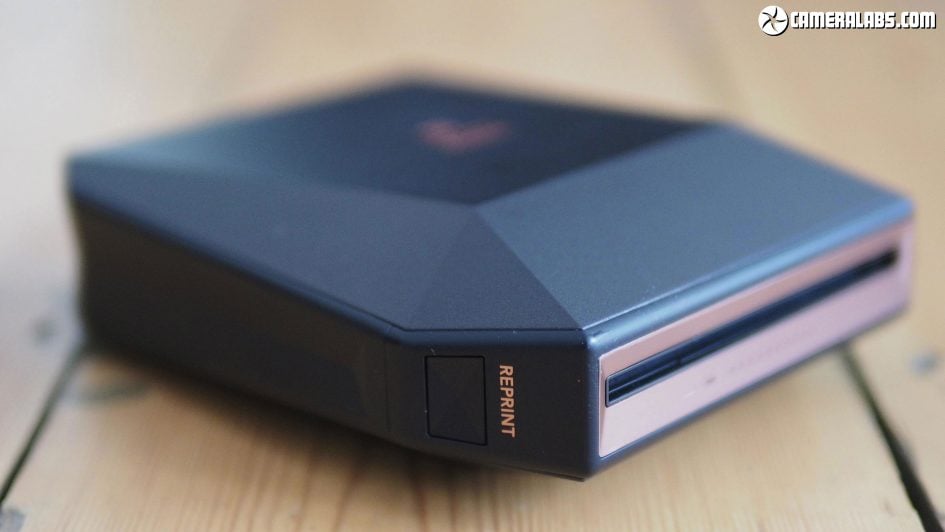
Above: Fujifilm has the INSTAX Share SP2 and SP3 (above) which print on Mini or Square prints respectively.
Canon Zoemini S / IVY Cliq+ verdict
The Canon Zoemini S is a pocketable instant camera that’ll capture 8 Megapixel images, output them as 2x3in instant prints, and also record them to a Micro SD card if desired. The Zero Ink – or Zink – printing technology lacks the high contrast and vibrancy of Fujifilm’s INSTAX prints, but the actual photo area is bigger, borderless, has a sticky back and is a little cheaper too at around 50p or cents a print versus around 70p or cents for INSTAX Mini.
The Zoemini S is considerably slimmer than the INSTAX cameras making it genuinely pocketable, the eight LEDs around the lens do a fair job as a flattering ring-light for selfies, while the digital sensor within means it gets to exploit auto exposure, auto ISO and auto white balance, making it better-equipped to handle broad lighting situations than Fujifilm’s fully-analogue instant cameras.
Sadly it doesn’t go as far as to include a screen for reviewing images before printing, and it won’t take a photo without there being paper loaded. If you prefer to review before you print, you can connect your phone over Bluetooth and print any photo stored on it using the free app, although if you prefer this flexibility over using the built-in camera, you may be better off just buying a portable instant printer, such as Canon’s original Zoemini, or Kodak’s SMILE printer, or one of the Fujifilm INSTAX share models.
Overall the Zoemini S is a fun camera to use and its size means you’ll take it out more than many rivals, I’ve also not met anyone, young or old, who’s not spellbound by a low-cost camera that pumps out instant prints, making it’s perfect for events or breaking the ice in street photography, although do compare the Zoemini closely with Kodak’s similar SMILE cameras which also use Zink but include a basic screen, and of course Fujifilm’s INSTAX range which starts with the cheaper Mini 9 cameras and ends with the digital SQ20 which lacks the wireless phone printing, but is a more powerful standalone camera.
Check prices on the Canon IVY Cliq+ at Amazon, B&H or Adorama. If you're in the UK, check prices on the Canon Zoemini S at WEX. Alternatively get yourself a copy of my In Camera book or treat me to a coffee! Thanks!